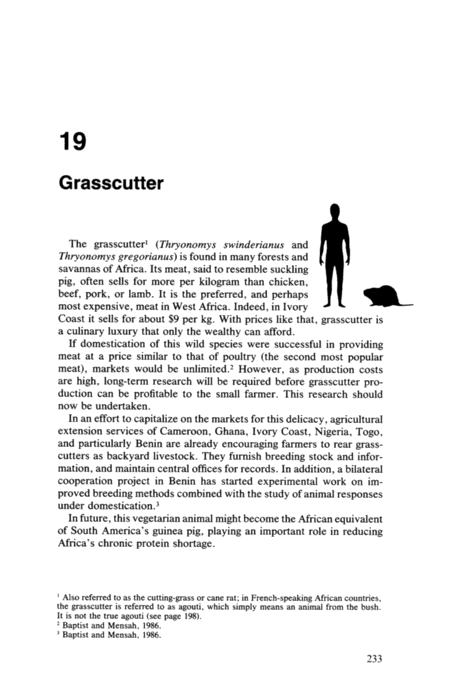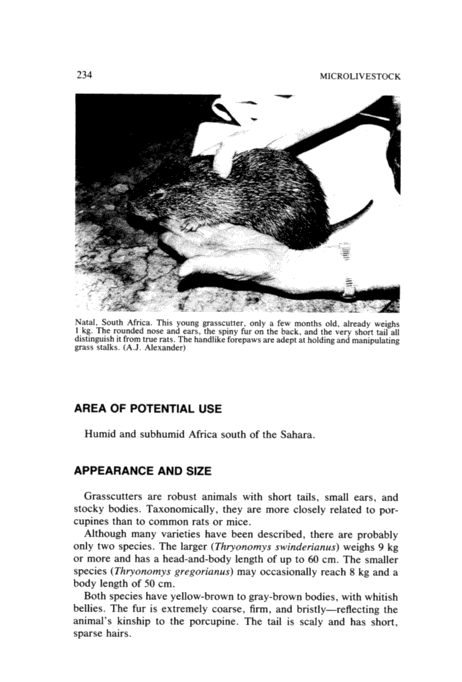Below is the uncorrected machine-read text of this chapter, intended to provide our own search engines and external engines with highly rich, chapter-representative searchable text of each book. Because it is UNCORRECTED material, please consider the following text as a useful but insufficient proxy for the authoritative book pages.
19 Grasscutter The grasscutter~ (Thryonomys swinderianus and Thryonomys gregorianus) is found in many forests and savannas of Africa. Its meat, said to resemble suckling pig, often sells for more per kilogram than chicken, beef, pork, or lamb. It is the preferred, and perhaps most expensive, meat in West Africa. Indeed, in Ivory Coast it sells for about $9 per kg. With prices like that, grasscutter is a culinary luxury that only the wealthy can afford. If domestication of this wild species were successful in providing meat at a price similar to that of poultry (the second most popular meat), markets would be unlimited.2 However, as production costs are high, long-term research will be required before grasscutter pro- duction can be profitable to the small farmer. This research should now be undertaken. In an effort to capitalize on the markets for this delicacy, agricultural extension services of Cameroon, Ghana, Ivory Coast, Nigeria, Togo, and particularly Benin are already encouraging farmers to rear grass- cutters as backyard livestock. They furnish breeding stock and infor- mation, and maintain central offices for records. In addition, a bilateral cooperation project in Benin has started experimental work on im- proved breeding methods combined with the study of animal responses under domestication.3 In future, this vegetarian animal might become the African equivalent of South America's guinea pig, playing an important role in reducing Africa's chronic protein shortage. ' Also referred to as the cutting-grass or cane rat; in French-speaking African countries, the grasscutter is referred to as agouti, which simply means an animal from the bush. It is not the true agouti (see page 198). 2 Baptist and Mensah, 1986. 3 Baptist and Mensah, 1986. 233
MICROLIVESTOCK Natal, South Afnca. This young grasscutter, only a few months old, already weighs 1 kg. The rounded nose and ears, the spiny fur on the back, and the very shalt tail all distinguish it from true rats. The handlike forepaws are adept at holding and manipulating grass stalks. (A.J. Alexander) AREA OF POTENTIAL USE Humid and subhumid Africa south of the Sahara. APPEARANCE AND SIZE Grasscutters are robust animals with short tails, small ears, and stocky bodies. Taxonomically, they are more closely related to por- cupines than to common rats or mice. Although many varieties have been described, there are probably only two species. The larger (Thryonomys swinderianus) weighs 9 kg or more and has a head-and-body length of up to 60 cm. The smaller species (Thryonomys gregorianus) may occasionally reach 8 kg and a body length of 50 cm. Both species have yellow-brown to gray-brown bodies, with whitish bellies. The fur is extremely coarse, firm, and bristly reflecting the animal's kinship to the porcupine. The tail is scaly and has short, sparse hairs.
GRAS S C UTTER 235 Both species have thick, heavy claws and enormous orange incisors that can chew through even the toughest vegetation. (Grasscutters have been known to tear holes in corrugated iron fences.) Nevertheless, they do not bite when handled, although their claws sometimes cause . . · A nJurles.~ DISTRIBUTION Grasscutters occur in grassland or in wooded savanna throughout the humid and subhumid areas of Africa south of the Sahara. They often live in forest-savanna habitats where grass is present. They do not inhabit rainforest, dry scrub, or desert, but they have colonized the road borders in forest regions. Distribution is determined by availability of adequate or preferred grass species for food. Specifically, Thryonomys swinderianus occurs in virtually all countries of west, east, and southern Africa. Thryonomys gregorianus occurs in savannas in Cameroon, Central African Republic, Zaire, Sudan, Ethiopia, Kenya, Uganda, Tanzania, Malawi, Zambia, Zimbabwe, and Mozambique. STATUS Despite heavy hunting, these animals are not threatened with extinction. Nonetheless, many individual populations are well below carrying capacity, or are extinct because of local overexploitation. HABITAT AND ENVIRONMENT The larger grasscutter (T. swinderianus) generally lives in swampy, low-lying areas, especially along river banks and the borders of lakes and streams. Occasionally, it is found on higher ground among bushes and rocks, living where savanna grasses are dense and tangled enough to afford good cover. In Ivory Coast and southern Guinea, for instance, grasscutters are found (and hunted) throughout the savanna zones. And they can occur in close proximity to farmlands and people (for example, in southwest Nigeria). BIOLOGY Although the precise diet in the wild has not been determined, 4 Information from W. Schroder and S. von Korn.
236 MICROLIVESTOCK Thryonomys swinderianus \_, Thryonomys gregorianus o Grasscutters occur across tropical Africa and through the grasslands of East Africa, as far south as the eastern Cape. Throughout this region, where other meat is often expensive and scarce, a grasscutter makes a welcome meal. grasscutters are vegetarian. They consume nuts, bark, and the soft parts of grasses and shrubs. They particularly favor elephant grass and sweet potatoes. They commonly "raid" cassava and yam plan- tations, and are considered local pests. Grasscutters reproduce year-round, although the births seem to peak at certain times of the year, correlated with weather conditions.5 Probably one male takes several females, and the family group possibly has more than one generation of young. The gestation is about 152 days. Apparently, litters normally contain between 2 and 4 young, but in Benin and Togo some litters of up to 11 or 12 are reported.6 Newborns are fully developed, their eyes are open, they weigh approximately 80 g, have thick fur, and quickly become accomplished runners. BEHAVIOR Although they commonly forage in groups, grasscutters are generally solitary. They are nocturnal, and they travel at night through trails in s Information from W. Schroder and S. von Korn. 6 Information from G. Mensah and from W. Schroder and S. von Korn.
GRASSCUTTER 237 reeds and grass, often to water. Most specimens seen in markets are males, possibly because males lead the groups and are thus most prone to being trapped. When alarmed, these animals stamp their hind feet and give a strange booming grunt. When fleeing, they can run very fast and, given a chance, will take to water. They swim with ease. For shelter, grasscutters usually weave nests of matted vegetation or scoop out shallow burrows. USES In a broad geographic band across sub-Saharan Africa, cattle raising is severely limited by trypanosomiasis. There, other sources of animal protein, including rodents, are traditionally used. Thus, grasscutter meat constitutes an important food for many Africans. The animals are mostly caught and eaten by families for their own use, but some are sold in markets and especially in roadside stalls. Many families depend exclusively on selling bushmeat, particularly that of grasscut- ters. In Accra, Ghana, during one year, 73 tons of grasscutter meat were sold in the local market. This represented more than 15,000 animals. In southern Africa, too, people find that these rodents make tasty food, although they may cut off the tail to make the carcass look less catlike. The meat is usually eaten smoked, and is so much in demand that grasscutters are hunted in organized drives with spears, dogs, and sometimes fire. It is considered excellent, especially when cooked in soups and stews or barbecued.7 It has been described as resembling venison in flavor, but it is dark like the meat of wild duck. HUSBANDRY In the savanna area of West Africa, people have traditionally captured wild grasscutters and raised them at home. As an extension of this, organized grasscutter husbandry has been initiated in West Africa. The animals are provided with marshy, tightly fenced areas with plenty of plant cover. The young are harvested from these areas and raised separately. Ghanaian researcher Emanuel Asibey, a pioneer of this research, reports success at getting such captive stocks to reproduce. To this end, farmers are provided with breeding boxes and foundation grass 7 Information from E.S. Ayensu.
238 MICRO LIVE STOC K cutter colonies. They are taught how to rear and feed the animals for home consumption or for cash income. Basically, the farmers make available large sheds where the animals can move freely. To prevent escape, the walls may be reinforced with cement plaster. The farmers also provide piles of grass, sugarcane, and other foods. A grasscutter reportedly takes about a month to adjust to such confinement. High mortality can occur in this period. The average weight of a mature, home-raised grasscutter is =7 kg. The average killing-out (dressed carcass) is 64 percent.8 The Wildlife Domestication Unit of Ibadan University in Nigeria, another pioneer of rodent domestication, has also reported the potential of domesticated grasscutter colonies.9 Research on grasscutter breeding, husbandry, and feeding is similarly being implemented by the Ministry for Rural Development in Benin and at the Lacena in Ivory Coast (see Research Contacts). ADVANTAGES The demand for grasscutter meat is so large that it is not being met. Markets for it already exist over much of Africa. LIMITATIONS Grasscutters can devastate such crops as rice, sugarcane, soybeans, peanuts, yams, cassava, sweet potatoes, oil-palm seedlings, maize, young rubber, sorghum, and wheat. Therefore, as with most rodents, they should be reared only in areas where they already exist. In past years, captive animals in Benin have suffered fatal Clostridium infections during September and October. In 1986, a broad-spectrum antibiotic was given with outstanding results. During this season, the animals also suffered from ascarid worms, which were also successfully treated with standard drugs.~° RESEARCH AND CONSERVATION NEEDS Research is needed in the following areas: · Digestive physiology, feeding habits, feed preferences, feed con- version and growth rate; ~ Information from E.O.A. Asibey. 9 Tewe, Ajayi, and Faturoti, 1984. 'I Information from W. Schroder and S. von Korn.
GRASSCUTTER 239 · Diseases (pathogens and parasites); · Captive breeding and management (growth rates, space require- ments, feed needs, etc); · Performance under different environments; · Productivity; and · Basic biology (for example, chromosome type, reproductive phys- iology, and social behavior both in its wild state and under controlled conditions). Moreover, specimens should be gathered from different regions for comparative evaluation. A particular need is to select and breed docile specimens because today, even after several generations in captivity, the animal must still be handled with caution. Although domestication of the grasscutter is encouraged, wild populations might also be managed to maximize and sustain production through habitat manipulation.
I: - ~: 'r ,'V'~4 ~ ,~P;~. ''`; ,.~,~g · : .... . .... ,: ~ . .',.' ~*4 .. .,. ,. Of ., ., ;. :,, : a' i i,,.' .:"~"-'








